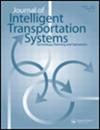具有可靠最优解的传感器定位模型,用于观察出发地矩阵和路线流
IF 2.8
3区 工程技术
Q3 TRANSPORTATION
Journal of Intelligent Transportation Systems
Pub Date : 2024-11-01
DOI:10.1080/15472450.2023.2247329
引用次数: 0
摘要
始发-目的地矩阵(ODM)是交通运输研究中的一个重要内容。近几十年来,自动车辆识别(AVI)传感器等新型ITS技术的出现,使ODM观测问题变得更加有趣。然而,传感器在现实生活中往往会出现故障,这就突出了传感器故障现象在实际问题中的重要性。本研究拟将传感器失效现象纳入AVI传感器定位模型(SLM)中,以实现对ODM和路径流的可靠观测。虽然可靠性和成本通常是两个相互冲突的目标,但我们试图回答以下问题:“是否有可能在不增加成本的情况下,仅通过改变传感器部署来提高可靠性?”在解决这个研究问题时,首先,它表明最近的AVI slm的解决方案不是唯一的。其次,我们证明了多个最优解的可靠性水平是不相同的。第三,考虑传感器失效现象,建立了用于ODM/路由流可靠观测和部分观测的混合整数线性规划(MILP) AVI线性规划模型。这些模型的制定使得它们的解从多个最优解的集合中选择。第四,引入了可靠性的线性替代项,并在数学上证明了该替代项包含在所提出的模型中。最后,在几个中等规模的网络和一个实际规模的网络上验证了所提出模型的适用性。此外,针对实际规模的网络,定制了一种启发式算法来求解模型。结果表明,对于ODM/路由流观测,可能存在与最优解决方案中传感器数量相同但可靠性更高的替代传感器部署策略。本文章由计算机程序翻译,如有差异,请以英文原文为准。
Sensor location models with reliable optimal solution for the observation of origin–destination matrix and route flows
Origin–destination matrix (ODM) is a key element in transportation studies. The emergence of new ITS technologies like Automatic Vehicle Identification (AVI) sensors makes the ODM observation problem more interesting in recent decades. However, sensors are subject to failure in reality which highlights the sensor failure phenomenon as a significant issue in real-case problems. This study intends to include the sensor failure phenomenon in AVI Sensor Location Model (SLM) for reliable observation of ODM and route flows. While reliability and cost are usually two conflicting objectives, we try to answer the following question “Is it possible to improve reliability without increasing the cost and only by changing sensor deployment?”. In addressing this study question, first, it is shown that the solution of recent AVI SLMs are not unique. Second, we show that the reliability level of multiple optimal solutions is not the same. Third, two Mixed Integer Linear Programming (MILP) AVI SLMs for reliable observation and parital observation of ODM/route flows are developed considering the sensor failure phenomenon. The models are formulated such that their solutions are selected from the set of multiple optimal solutions. Fourth, a linear surrogate term for reliability is introduced and mathematically proven to be included in the proposed models. Finally, the applicability of the proposed models is examined on several middle-scale networks and a real-size network. Furthermore, a heuristic algorithm is customized to solve the models for the real-size network. The results suggest that there might be alternative sensor deployment strategies with the same number of sensors as in the optimal solution but with higher level of reliability for ODM/route flows observation.
求助全文
通过发布文献求助,成功后即可免费获取论文全文。
去求助
来源期刊
CiteScore
8.80
自引率
19.40%
发文量
51
审稿时长
15 months
期刊介绍:
The Journal of Intelligent Transportation Systems is devoted to scholarly research on the development, planning, management, operation and evaluation of intelligent transportation systems. Intelligent transportation systems are innovative solutions that address contemporary transportation problems. They are characterized by information, dynamic feedback and automation that allow people and goods to move efficiently. They encompass the full scope of information technologies used in transportation, including control, computation and communication, as well as the algorithms, databases, models and human interfaces. The emergence of these technologies as a new pathway for transportation is relatively new.
The Journal of Intelligent Transportation Systems is especially interested in research that leads to improved planning and operation of the transportation system through the application of new technologies. The journal is particularly interested in research that adds to the scientific understanding of the impacts that intelligent transportation systems can have on accessibility, congestion, pollution, safety, security, noise, and energy and resource consumption.
The journal is inter-disciplinary, and accepts work from fields of engineering, economics, planning, policy, business and management, as well as any other disciplines that contribute to the scientific understanding of intelligent transportation systems. The journal is also multi-modal, and accepts work on intelligent transportation for all forms of ground, air and water transportation. Example topics include the role of information systems in transportation, traffic flow and control, vehicle control, routing and scheduling, traveler response to dynamic information, planning for ITS innovations, evaluations of ITS field operational tests, ITS deployment experiences, automated highway systems, vehicle control systems, diffusion of ITS, and tools/software for analysis of ITS.

 求助内容:
求助内容: 应助结果提醒方式:
应助结果提醒方式:


